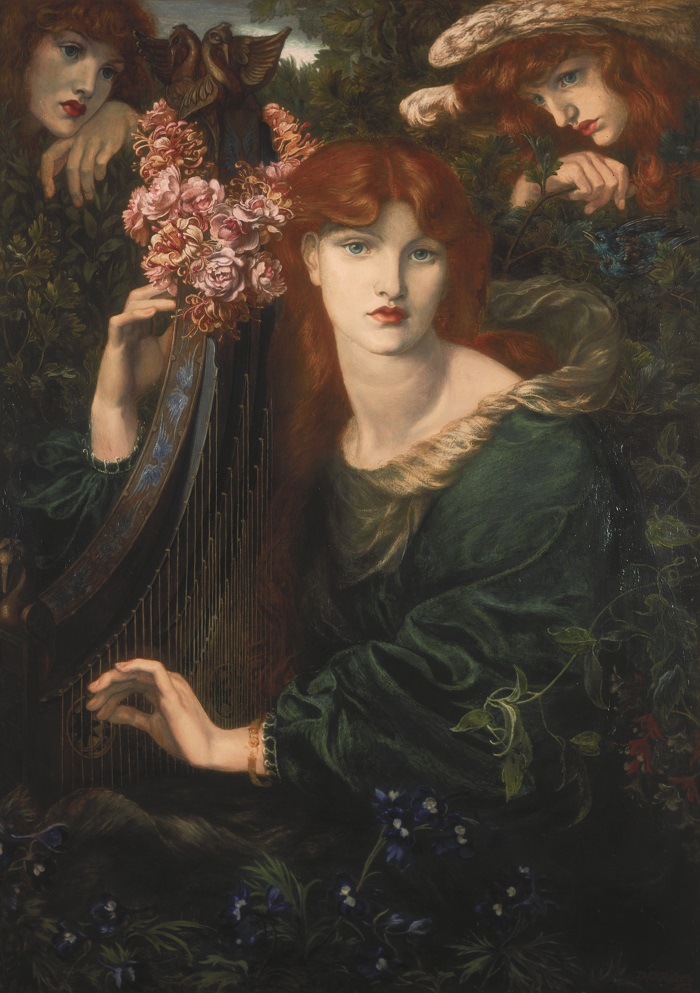 A major exhibition charting the romance and radicalism of the Rossetti generation – Dante Gabriel, Christina and Elizabeth (neé Siddal) – has just opened at Tate Britain.
A major exhibition charting the romance and radicalism of the Rossetti generation – Dante Gabriel, Christina and Elizabeth (neé Siddal) – has just opened at Tate Britain.
Showcasing their revolutionary approach to life, love and art and moving through and beyond the Pre-Raphaelite years, The Rossettis features over 150 paintings and drawings as well as photography, design, poetry and more.
This is the first retrospective of Dante Gabriel Rossetti ever held at Tate and the largest exhibition of his work in two decades. It spans the two avant-garde movements that he originated, bringing together his Pre-Raphaelite oil paintings and many of his later iconic Aesthetic canvases.
This is also the first retrospective of Elizabeth Siddal for 30 years, featuring her rare surviving watercolours and important drawings.
Christina’s and Dante Gabriel’s poetry are interwoven with these artworks through spoken word and beautifully illustrated editions of their work.
The Rossettis led a progressive counterculture. The children of an Italian revolutionary exile, they grew up in London in a scholarly family and they began their artistic careers as teenagers. The exhibition begins with a celebration of their young talent, opening with Christina’s first edition of poems, published when she was 16, and Dante Gabriel’s Ecce Ancilla Domine (The Annunciation) 1850, the stark and evocative painting for which Christina and their brother William Michael posed.
Works from the Pre-Raphaelite years demonstrate how the spirit of popular revolution inspired these artists to initiate what has been recognised as the first British avant-garde movement. More personal forms of revolution are explored through the Rossettis’ refusal to abide by the constraints of Victorian society. Works such as Dante Gabriel’s Found begun 1854, Elizabeth Siddal’s Lady Clare 1857 and Christina’s poem The Goblin Market 1859 show how they questioned love in an unequal and materialist world.
Following new research, Elizabeth’s surviving watercolours are shown in a two-way dialogue with contemporary works by Dante Gabriel, exploring modern love in jewel-like medieval settings. As a working-class artist who was largely self-taught, Elizabeth’s work was highly original and inventive, but has often been overshadowed by her renown as a tragic muse. Seen together, Elizabeth’s and Dante Gabriel’s work mark the turning point from Pre-Raphaelitism to the imaginative and expressive Aesthetic style.
The exhibition takes a fresh look at the fascinating myths surrounding the unconventional relationships between Dante Gabriel, Elizabeth Siddal, Fanny Cornforth and Jane Morris. The Aesthetic portraits from the later part of Dante Gabriel’s career, such as Bocca Baciata 1859, Beata Beatrix c.1864-70 and The Beloved 1865-73, are shown in the context of the achievements and experiences of the working women who inspired them.
Alongside art and poetry, visitors can experience how the Rossettis’ trailblazing new lifestyles transformed the domestic interior through contemporary furniture, clothing and design. The exhibition concludes by showing how the Rossettis inspired the next generation and how they continue to influence radical art and culture to this day.
The Rossettis is now open at Tate Britain (until 24 September). For further information: tate.org.uk
Smith Greenfield is an independent insurance broker specialising in insurance for exclusive lifestyles and collectors of valuable objects including: art insurance, antiques insurance, watch insurance, jewellery insurance, vintage car insurance, fine wine insurance and more. To discuss specialist insurance for your lifestyle, please contact our Premier Client Adviser, Imran Moideen, via email imran.moideen@smithgreenfield.co.uk
Image: Dante Gabriel Rossetti, La Ghirlandata, 1873 © Guildhall Art Gallery

